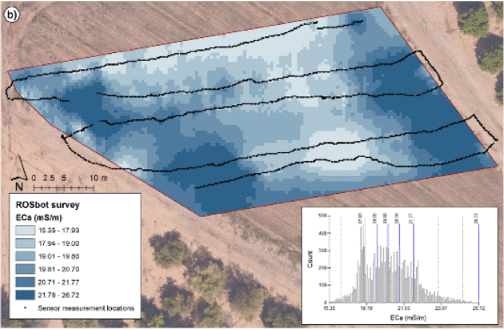A Portable Agricultural Robot For Continuous Apparent Soil Electrical Conductivity Measurements
Patent Status
| Country | Type | Number | Dated | Case |
| United States Of America | Published Application | 20230400446 | 12/14/2023 | 2022-877 |
Full Description
Background:
Precision irrigation helps growers increase revenue and reduce environmental footprint by applying water directly where and when required. Accurate estimates of water available to plant roots can be obtained with soil sensors. Only 12% of growers in the US use root-zone soil measurements to trigger and budget irrigation. The growers that use these measurements rely on an expensive network of decentralized sensors that generally only measure a few points. The lean sampling fails to capture soil spatial variability – a key component of plant-water-environment relationship.
Capturing measurements with a robotic system helps remove several barriers that prevent the wider adoption of soil moisture measurements.
Technology:
Prof. Konstantinos Karydis and his research team at UCR have invented a novel, integrated robotic soil sensor platform. The compact robot serves as a reliable and accurate platform for performing continuous electrical conductivity (EC) measurements as part of a soil mapping (SM) survey. Through experimentation the team has an appropriate configuration for mounting the sensor without compromising the robot’s mobility and operating envelope.

Map of soil apparent electrical conductivity (ECa) for the 0–0.7m soil profile at the study site with ROSbot. Color scales are characterized with the quantile method. The maps' ECa frequency distribution are reported on a histogram on the bottom-right of panel.
Advantages
- The robot’s small, unique form factor allows it to gain access to the root zone under tree canopies.
- The measurements are non-invasive and do not require direct sampling.
- The robot utilizes carbon fiber rods to hold and position the sensor without introducing measurement bias and offers portability.
- Optimized size, weight and power consumption (SwaP) of the robot.
- Developed software stack enables autonomous logging of geo-referenced EC measurements.
- Geospatial SM data are displayed in real-time and captured as well for post-processing.
- The ground robot allows for denser spatial resolution which is valuable when generating soil moisture maps with minimal interpolation.
Suggested uses
This low SWaP robot platform is valuable for:
State Of Development
Working prototype of the robot has been built and the team is currently working on specialized navigation algorithm for root zone navigation.
Related Technology
Please review all technologies developed by Prof. Karydis and his team at UCR.
Related Materials
Contact
- Venkata S. Krishnamurty
- venkata.krishnamurty@ucr.edu
- tel: View Phone Number.
Other Information
Keywords
Robotics, Precision Agriculture, Agtech, Irrigation, Soil sampling, Soil health
